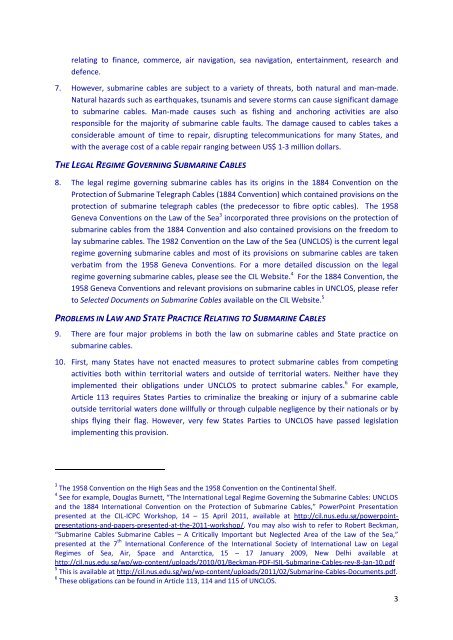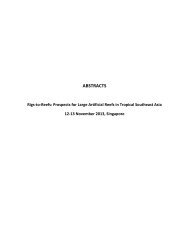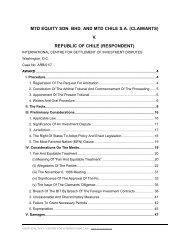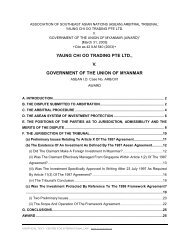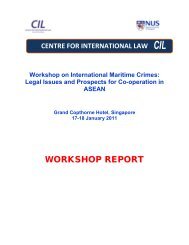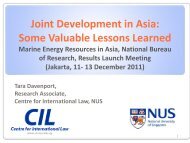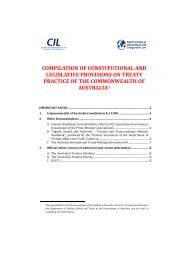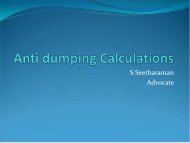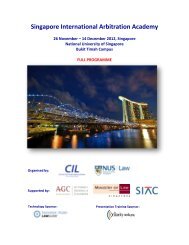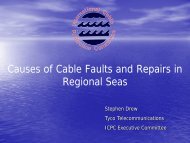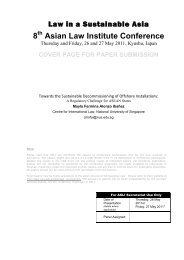Download in PDF format - Centre for International Law
Download in PDF format - Centre for International Law
Download in PDF format - Centre for International Law
Create successful ePaper yourself
Turn your PDF publications into a flip-book with our unique Google optimized e-Paper software.
elat<strong>in</strong>g to f<strong>in</strong>ance, commerce, air navigation, sea navigation, enterta<strong>in</strong>ment, research and<br />
defence.<br />
7. However, submar<strong>in</strong>e cables are subject to a variety of threats, both natural and man-made.<br />
Natural hazards such as earthquakes, tsunamis and severe storms can cause significant damage<br />
to submar<strong>in</strong>e cables. Man-made causes such as fish<strong>in</strong>g and anchor<strong>in</strong>g activities are also<br />
responsible <strong>for</strong> the majority of submar<strong>in</strong>e cable faults. The damage caused to cables takes a<br />
considerable amount of time to repair, disrupt<strong>in</strong>g telecommunications <strong>for</strong> many States, and<br />
with the average cost of a cable repair rang<strong>in</strong>g between US$ 1-3 million dollars.<br />
THE LEGAL REGIME GOVERNING SUBMARINE CABLES<br />
8. The legal regime govern<strong>in</strong>g submar<strong>in</strong>e cables has its orig<strong>in</strong>s <strong>in</strong> the 1884 Convention on the<br />
Protection of Submar<strong>in</strong>e Telegraph Cables (1884 Convention) which conta<strong>in</strong>ed provisions on the<br />
protection of submar<strong>in</strong>e telegraph cables (the predecessor to fibre optic cables). The 1958<br />
Geneva Conventions on the <strong>Law</strong> of the Sea 3 <strong>in</strong>corporated three provisions on the protection of<br />
submar<strong>in</strong>e cables from the 1884 Convention and also conta<strong>in</strong>ed provisions on the freedom to<br />
lay submar<strong>in</strong>e cables. The 1982 Convention on the <strong>Law</strong> of the Sea (UNCLOS) is the current legal<br />
regime govern<strong>in</strong>g submar<strong>in</strong>e cables and most of its provisions on submar<strong>in</strong>e cables are taken<br />
verbatim from the 1958 Geneva Conventions. For a more detailed discussion on the legal<br />
regime govern<strong>in</strong>g submar<strong>in</strong>e cables, please see the CIL Website. 4 For the 1884 Convention, the<br />
1958 Geneva Conventions and relevant provisions on submar<strong>in</strong>e cables <strong>in</strong> UNCLOS, please refer<br />
to Selected Documents on Submar<strong>in</strong>e Cables available on the CIL Website. 5<br />
PROBLEMS IN LAW AND STATE PRACTICE RELATING TO SUBMARINE CABLES<br />
9. There are four major problems <strong>in</strong> both the law on submar<strong>in</strong>e cables and State practice on<br />
submar<strong>in</strong>e cables.<br />
10. First, many States have not enacted measures to protect submar<strong>in</strong>e cables from compet<strong>in</strong>g<br />
activities both with<strong>in</strong> territorial waters and outside of territorial waters. Neither have they<br />
implemented their obligations under UNCLOS to protect submar<strong>in</strong>e cables. 6 For example,<br />
Article 113 requires States Parties to crim<strong>in</strong>alize the break<strong>in</strong>g or <strong>in</strong>jury of a submar<strong>in</strong>e cable<br />
outside territorial waters done willfully or through culpable negligence by their nationals or by<br />
ships fly<strong>in</strong>g their flag. However, very few States Parties to UNCLOS have passed legislation<br />
implement<strong>in</strong>g this provision.<br />
3 The 1958 Convention on the High Seas and the 1958 Convention on the Cont<strong>in</strong>ental Shelf.<br />
4 See <strong>for</strong> example, Douglas Burnett, “The <strong>International</strong> Legal Regime Govern<strong>in</strong>g the Submar<strong>in</strong>e Cables: UNCLOS<br />
and the 1884 <strong>International</strong> Convention on the Protection of Submar<strong>in</strong>e Cables,” PowerPo<strong>in</strong>t Presentation<br />
presented at the CIL-ICPC Workshop, 14 – 15 April 2011, available at http://cil.nus.edu.sg/powerpo<strong>in</strong>tpresentations-and-papers-presented-at-the-2011-workshop/.<br />
You may also wish to refer to Robert Beckman,<br />
“Submar<strong>in</strong>e Cables Submar<strong>in</strong>e Cables – A Critically Important but Neglected Area of the <strong>Law</strong> of the Sea,”<br />
presented at the 7 th <strong>International</strong> Conference of the <strong>International</strong> Society of <strong>International</strong> <strong>Law</strong> on Legal<br />
Regimes of Sea, Air, Space and Antarctica, 15 – 17 January 2009, New Delhi available at<br />
http://cil.nus.edu.sg/wp/wp-content/uploads/2010/01/Beckman-<strong>PDF</strong>-ISIL-Submar<strong>in</strong>e-Cables-rev-8-Jan-10.pdf<br />
5 This is available at http://cil.nus.edu.sg/wp/wp-content/uploads/2011/02/Submar<strong>in</strong>e-Cables-Documents.pdf.<br />
6 These obligations can be found <strong>in</strong> Article 113, 114 and 115 of UNCLOS.<br />
3


